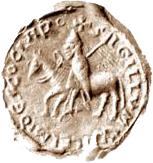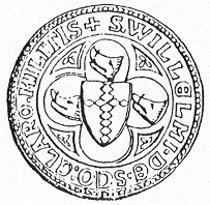St. Clair of Rosslyn
The arrival of ‘les Saynclers‘ with Scottish king William the Lion in 1174 founded a St. Clair dynasty in Scotland that has survived to the present day, although the Rosslyn line ended with William, the ‘Last of the Rosslyns’, in 1778.
Their establishment in Scotland depended to a great extent on the support they received from the de Morville family. Hugh de Morville obtained a tenancy in the 1120s in Northamptonshire from David I, king of Scotland, of the honour of Huntingdon, adjacent to lands held by William de Sancto Claro. Hugh married Beatrice de Beauchamp, a member of the family who held large estates in Bedfordshire nearby Eaton Socon and Sandy, held by Hamon de Sancto Claro, William’s brother. Hamon lost these Bedfordshire estates to Hugh de Beauchamp when Henry II became king in 1154.
Hugh and Beatrice left England and Hugh became constable to the king of Scotland, a hereditary office. Richard, Hugh’s son, and William, his grandson, succeeded him. The first Henry de St. Clair recorded in Scotland was the baronial sheriff of Lauder, one of the two great regional fiefs in Scotland given to Hugh by David I.
The earliest evidence of a St. Clair obtaining Rosslyn is that of Father Hay’s record of a charter from king Alexander II in 1244. Nisbet claimed that it was granted in 1180, but there is no surviving charter to prove this. Hay was confused as to whether Alexander II or III granted it in his 31st year, but it had to be Alexander II because a William de St. Clair was already recorded elsewhere as holding Rosslyn before 1280, the 31st year of Alexander III. Whether the ‘Henry of Rosslyn’ who released it to Alexander II was Henry de St. Clair’s son may always remain a mystery.
According to Hay, Henry de St. Clair, William’s son, was one of the barons of Scotland. Within a hundred years, their descendant, Sir Henry de St. Clair, had become the earl of Orkney through marriage. The earldom was lost in 1471 when the Scottish king James III forced William to part with it, compensating him with Ravenscraig Castle in Fife. The St. Clairs retained vast estates, however, but all this was to change in 1476 when Sir William gave Oliver, his oldest son by his second marriage, his Lothian lands, and those in the north to Oliver’s brother, William.
From that time, two distinct branches existed, the earls of Caithness and the lords of Rosslyn. A third branch from Sir William’s son by his first marriage was the Lords St. Clair (of Dysart) which was united with Herdmanston in 1659 when its male line failed. William St. Clair, the ‘Last of the Rosslyns’ died in 1778 without any legitimate male heirs. The title and ownership of Rosslyn Castle and what remained of the original estate passed to the Lords Sinclair and then to the current Erskine family through marriage.
Of course, many new branches of the Sinclair family were established by younger sons who remained in Scotland, or left the country to begin a new life, including ‘natural’ sons who carried the name but were denied any legitimacy because they were born outside of marriage. Also, many farmers working on the estates owned by the Sinclairs took their landowner’s name for their children, a common occurrence in feudal Scotland. In consequence, it is impossible to be sure who of the many Sinclairs around the world are descendants of the first William de St. Clair of Roslin. There is a family DNA programme that will help in time, but without verifiable documentation, the results will always remain uncertain.

